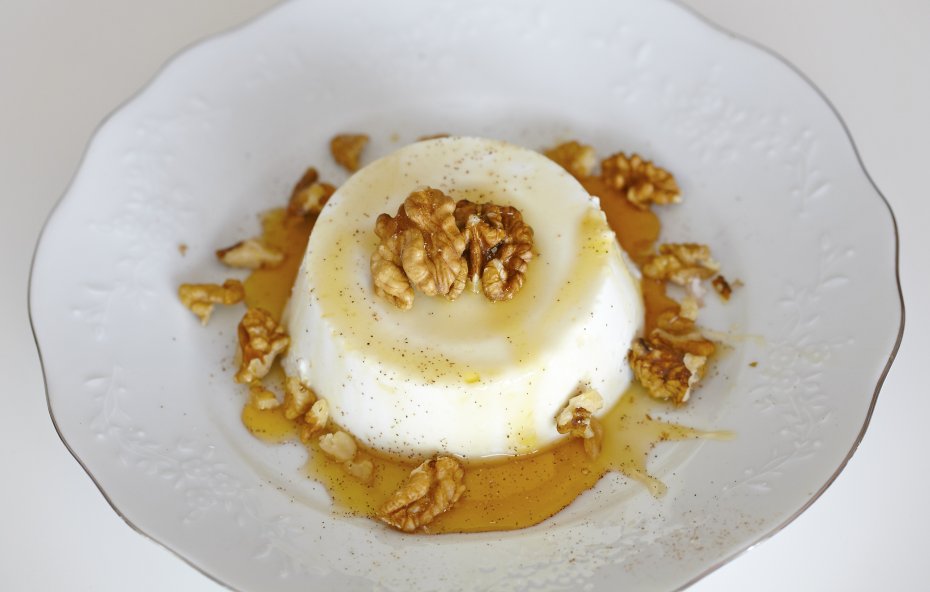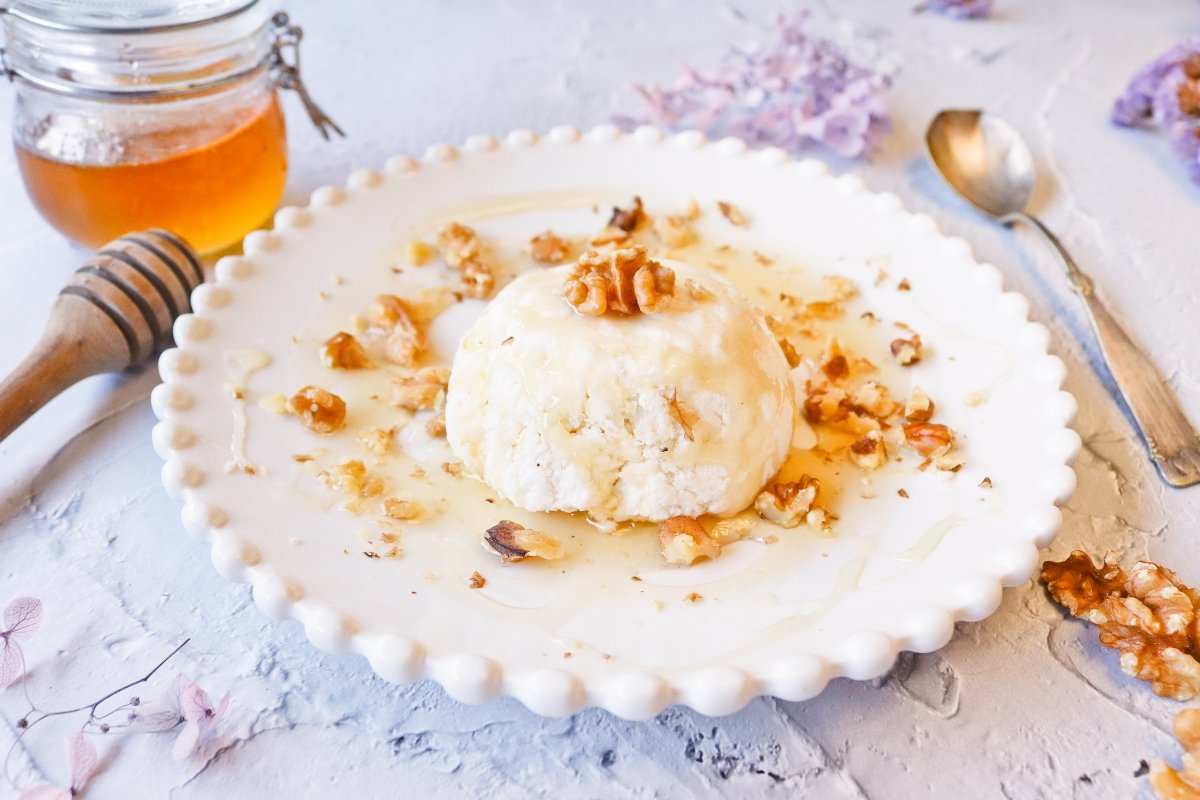On a recent journey, filled with discoveries and culinary adventures, I had the pleasure of encountering a sublime dessert that captured both my imagination and palate: Mel i Mató. This traditional Catalan delight perfectly combines the richness of whole milk transformed into a soft, fresh cheese with the natural sweetness of honey, often garnished with walnut halves to add a satisfying crunch. The contrast between the creamy texture of the mató and the viscous honey, punctuated by the earthy touch of walnuts, creates a festival of flavors that is both humble and luxurious.
Inspired by this delectable pairing, I embarked on a quest to master the delicate process of making Mel i Mató, diving deep into the balance of its simple yet profound ingredients. After numerous attempts, I’ve refined a technique that faithfully recreates the essence of this dessert, embodying the spirit of Catalan cuisine. It’s with great enthusiasm that I share this recipe with you, an invitation to indulge in a sweet melody of flavors that promises to bring a touch of Catalan charm to your table.

Mel i mató
Equipment
- 1 big heavy-bottomed pot
Ingredients
- 4 walnut halves
- 4 tablespoon runny honey
- 2 tablespoon lemon juice
- Water and salt
- 2 liters whole milk
Instructions
- In a big heavy-bottomed pot, bring the water to a boil.
- Stir in the lime juice as soon as the milk begins to boil and rise.
- Place the muslin or cheesecloth over a big bowl and line a big strainer with it.
- Pour the contents of the skillet into the lined strainer and rinse it with cold water.
- Fill four tiny cups or molds with drained curd, slightly overfilling, and top with a serving dish and a hefty weight on top.
- Allow 30 minutes to pass.
- In a medium frying pan, dry cook the walnuts for a few minutes.
- Remove from the pan and leave to cool.
- Place the cheeses on the serving dishes after removing them from the brine.
- Serve with a dry roasted nut on top of the cheese and honey drizzled on top.
Cooking tips about Mel i mató

- Quality of Ingredients: The success of Mel i mató hinges on the quality of its few but crucial ingredients. Choose the freshest, whole milk available for making mató (the fresh cheese component), and seek out high-quality, artisanal honey with a rich flavor profile. The choice of walnuts should also prioritize freshness, as their natural oils contribute a significant depth to the dish.
- Making Mató Cheese: If you’re adventurous enough to make the mató cheese at home, start with high-quality whole milk. Coagulation is traditionally encouraged with the addition of a little vinegar or lemon juice. Ensure gentle heating and careful handling to achieve the soft, delicate curds characteristic of mató. For those less inclined to make their own cheese, seeking out a high-quality ricotta can serve as a substitute, though it will slightly alter the traditional taste and texture of the dessert.
- Serving Balance: The beauty of Mel i mató lies in the balance of its components. Spread the mató cheese gently onto your serving dish, drizzle generously with honey, and then sprinkle with a handful of walnut halves. The proportions should allow each bite to carry the creamy texture of the cheese, the sweet floweriness of the honey, and the crunchy, earthy note of the walnuts.
- Enhancing Flavors: While simple, the dish allows for subtle enhancements. A light grating of lemon zest over the top can add a refreshing brightness, tying the flavors together. Similarly, a sprinkle of cinnamon or a drizzle of a flavored honey (such as lavender or truffle) can introduce an intriguing note without overwhelming the base ingredients.
- Temperature and Texture: Serve Mel i mató at a cool, but not cold, temperature. This ensures the cheese retains its creamy texture and the honey flows nicely when poured. Too cold, and the dish loses some of its sensory pleasures; too warm, and it may become overly runny.
- Presentation: Use simplicity and elegance in presenting this dessert. A clear glass dish or a rustic ceramic plate can accentuate the visual appeal of Mel i mató, showcasing the contrasting textures and colors of the ingredients.
- Pairing: Consider what to serve alongside Mel i mató. For a complete dessert experience, a sweet, fortified wine such as Moscatel or a late harvest wine complements the dish splendidly. Alternatively, a robust espresso can offer a delightful contrast to the sweetness of the honey and the creaminess of the cheese.
Serving suggestions about Mel i mató

- Traditional Serving: Present Mel i Mató in a manner that highlights its rustic elegance. Use a shallow bowl or a wide plate to gently spread the mató cheese, creating a smooth canvas. Drizzle the artisanal honey generously over the cheese, ensuring it covers the surface evenly, allowing some to pool around the edges of the cheese for an inviting look.
- Garnishing: Sprinkle walnut halves over the top of the honey-drizzled cheese. The walnuts not only add a textural contrast but also an earthy flavor that complements the sweetness of the honey and the tanginess of the mató cheese. For a visually appealing presentation, consider toasting the walnut halves slightly to deepen their flavor and add a warm color contrast against the white cheese.
- Flavor Enhancements: While Mel i Mató is exquisite in its traditional form, a few garnishes can add visual appeal and subtle flavor nuances. A light dusting of cinnamon or a sprinkle of fresh lemon zest can bring brightness to the dish. If available, edible flowers or a sprig of fresh mint can add a touch of elegance to the presentation, making it perfect for special occasions.
- Temperature Considerations: Serve Mel i Mató at cool room temperature. This ensures the cheese maintains its creamy texture, which is essential for the full sensory experience. Serving it too cold might mute the flavors, while too warm could affect the desired consistency of the cheese and honey.
- Pairings: Pair Mel i Mató with a crisp, light-bodied white wine or a glass of cava, which can complement the dessert without overpowering its delicate flavors. For a non-alcoholic option, a cup of freshly brewed herbal tea or a mild coffee can balance the sweetness of the dish beautifully.
- Dining Occasion: Mel i Mató is perfect as an elegant dessert to conclude a meal, but it can also shine as part of a brunch spread, offering a sweet counterpoint to savory dishes. Additionally, it makes for a refreshing afternoon treat, especially during the warmer months, when its cool, creamy texture can be particularly satisfying.
Top 5 FAQs about Mel i mató

- What makes Mel i mató different from similar cheese and honey desserts? The distinctiveness of Mel i mató comes from the use of mató cheese, a fresh, soft cheese similar to ricotta but with a unique Catalan twist. This cheese’s slightly tangy flavor contrasts beautifully with the sweetness of the honey, and when combined with the texture of walnuts, it offers an entirely unique taste and texture profile that sets it apart from other cheese and honey-based desserts.
- Can I use a cheese other than mató if I can’t find it? Yes, while traditional Mel i mató is made with mató cheese, you can substitute with high-quality ricotta or another similar fresh cheese if mató is not available in your area. Keep in mind that altering the cheese may slightly change the dessert’s authentic taste and texture, but these alternatives can still provide a delicious experience.
- What type of honey works best with Mel i mató? High-quality, artisanal honey with a rich flavor and floral notes complements Mel i mató best. The choice of honey can greatly influence the dish’s overall taste, with options like orange blossom, lavender, or wildflower honey providing delightful variations to explore.
- How should Mel i mató be served for the best experience? Mel i mató should be served at a cool but not cold temperature to ensure the cheese retains its creamy texture and the honey remains viscous. It is typically spread onto a serving plate, generously drizzled with honey, and sprinkled with walnut halves. Serving it this way allows for a perfect balance of flavors and textures with each bite.
- Is Mel i mató suitable for people with dietary restrictions? Mel i mató is vegetarian-friendly, making it suitable for those following a vegetarians diet. However, those with lactose intolerance or dairy allergies, as well as vegans, should avoid it due to the central role of cheese. For guests with nut allergies, omitting the walnut garnish or substituting it with another ingredient, such as a sprinkling of cinnamon or fresh berries, can be an excellent alternative.

Leave a Reply